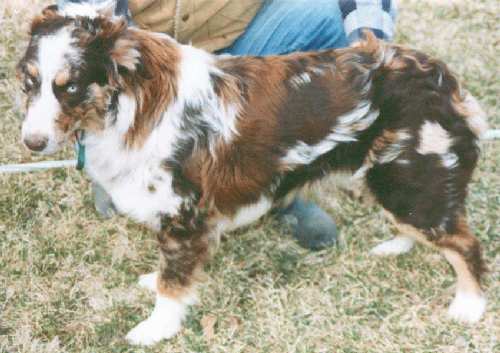
Harlequin is a dominant modifier of the merle pattern. When present, it allows the merle patches to vary in color from lacy pale blue or red to mid ranges of gray (or red in a harlequin red merle). There is another documented dominant modifier known as "tweed", which produces 4-5 intermediate shades of gray and rusty brown (or red in red merles) in a very regular pattern. It is unknown at this time whether the harlequin pattern as it occurs in Aussies is caused by the same gene as that which produces tweed (Phil Sponenberg, personal communication). The apparent difference may be only one of degree, with the harlequins having lacy white or near white areas and tweeds not having them. Test breedings would be required to determine whether one gene or two are responsible for the visual differences. The first reported tweed was Ritter's Lass (former director of ASCA Genetics Committee, Betty Nelson, personal communication). Lass produced at least one daughter with a clearly identifiable tweed pattern, and very likely she also produced others that do not have photos in the breed history archives. However, Ms. Nelson also stated that sometimes tweed crops up in families where it's never been seen before. She compares the phenomenon to "cropout overo" in horses. Perhaps the penetrance of the trait varies and the parents of such a cropout have very minimal expression of the gene.
Ordinary merles with a dilute patch or two are sometimes mistaken for harlequins but are not. Dogs with even several dilute patches don't begin to match the number and regularity of different colors of patches in the harlequin or tweed coat. Harlequin is a controversial pattern in the breed. The breed standard says, "...all colors strong, clear and rich...". In harlequins and tweeds the different colors are quite distinct and do not muddy or bleed into each other. The fuel for the controversy is that a very few harlequins have small lacy white areas on the body where the patch is depigmented completely. Some interpret this as a white body splash, a disqualifying fault in the Aussie. Others recognize that this is neither a piebald body splash nor the body splash indicative of a homozygous merle, but a byproduct of this type of modification of the merling action. In some harlequins the light areas fill in with pigment as the puppy matures, and in some they remain constant. The following photographs of harlequins are courtesy of Sandy Cornwell of the Fairoaks kennel. Many thanks to Sandy for documenting this unique and beautiful color variant of the merle.

This is Fairoaks Wolf Whistle, a harlequin red merle. His basic body color is a rich liver, and he has at least 3 distinct shades of merle. The color is diluted to lacy light red in a streak on his flank and on his knee. For lovers of color, this dog has it all - harlequin pattern, Irish spotting pattern, ticking, and tan points!
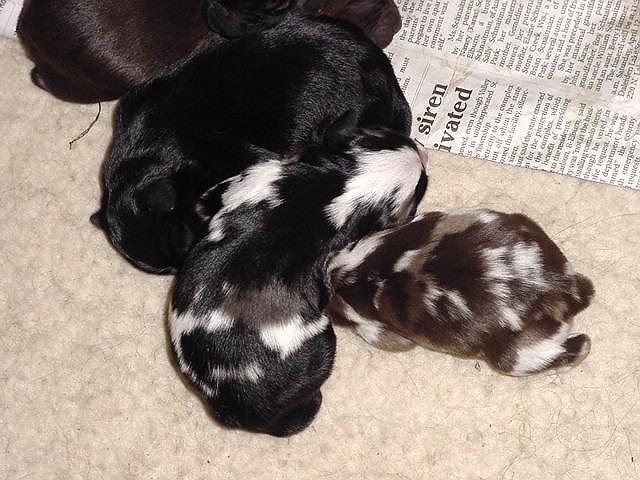
This is a litter of newborns, courtesy of Sandy Cornwell. The two top pups are nonmerles - one is dark red and one is black. The pup on the lower left is a blue merle harlequin, and the pup on the lower right is a red merle harlequin. Sandy notes that this litter is typical of most litters in which harlies occur - only the harlies have any white areas on the body. The nonmerles do not. These particular nonmerles don't even show an Irish spotting pattern. This suggests that the white areas are not body splashes produced by the "s" locus. If they were, you'd logically expect the nonmerles to have them also. These pups are not out of a merle to merle breeding, so MM is ruled out. The harlequin gene itself dilutes the body color to different degrees, including all the way to white areas in a few specimens. These white areas usually decrease in coverage substantially during the puppy's first year. Probably the white areas on these harlie pups will fill in quite a bit as pigmented areas spread over the next few months.

This is a Fairoaks puppy "Rico" at 8 weeks. He's a blue harlequin merle and he has a fair amount of very light blue areas on his body. That's about to change....

At 4 months, Rico's light areas have been filled in by adjacent colored areas encroaching on them. All that remain are a few lacy wisps of very light blue. Like Wolf Whistle, he has a nice Irish spotting pattern and modest ticking on the legs and collar.
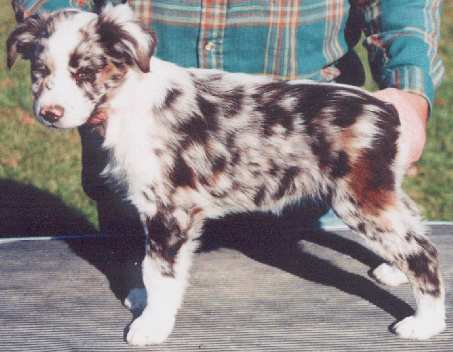
This is Fairoaks Allegro, a red harlequin merle at about 8 weeks. "Allie" also has several identifiable shades of merle including some light areas mottled on the body. She, too, will make a transformation....

This is Allie as a young adult. Her light areas have decreased dramatically, crowded out by encroaching pigmented areas around them. All she has left of them is a few wisps scattered about.


This gorgeous girl is Dustyroads IWannaDoItAll (S'mores), photos courtesy of Penny Slatton. She has bright variegation and at least 3 different shades of dilute patches. They are widely distributed over the body and not localized to just one area. Her father is a harlequin, her mom is not from a line known to produce them. She is heterozygous for the harlequin trait and would be expected to produce pups both with and without this modifier. Probably those very light lacy areas will fill in with pigment over time as they have in the other harlequins pictured.

This Aussie, not one of Sandy's, is a tweed (photo courtesy of Janine Torma). The base color is blue merle, and there are several identifiable intermediate shades of blue. They are more or less evenly distributed, unlike the occasional dilute spot you see in ordinary merles. The lightest background color is a pale blue with no lacy white areas. This dog resembles the tweeds in the original Lameroux/Sponenberg article in Journal of Heredity.
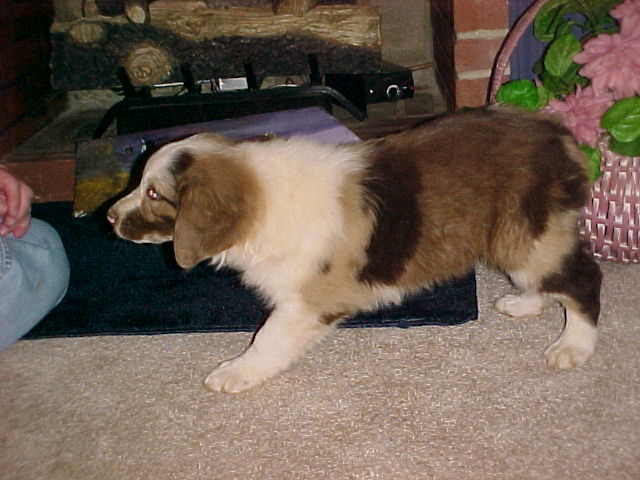

These two pups, Champ (top) and Chase (bottom) are also tweeds, out of WTCH Fairoaks Atoya (photos courtesy of Ronnie Bates). I've discussed them in the section on dilute spots, but they also bear mentioning here. Tweeds generally have 2 or more intermediate shades that are more or less regularly distributed on the body. These pups have only one intermediate shade each, but the distribution on the body is fairly regular in terms of amount of total coverage.
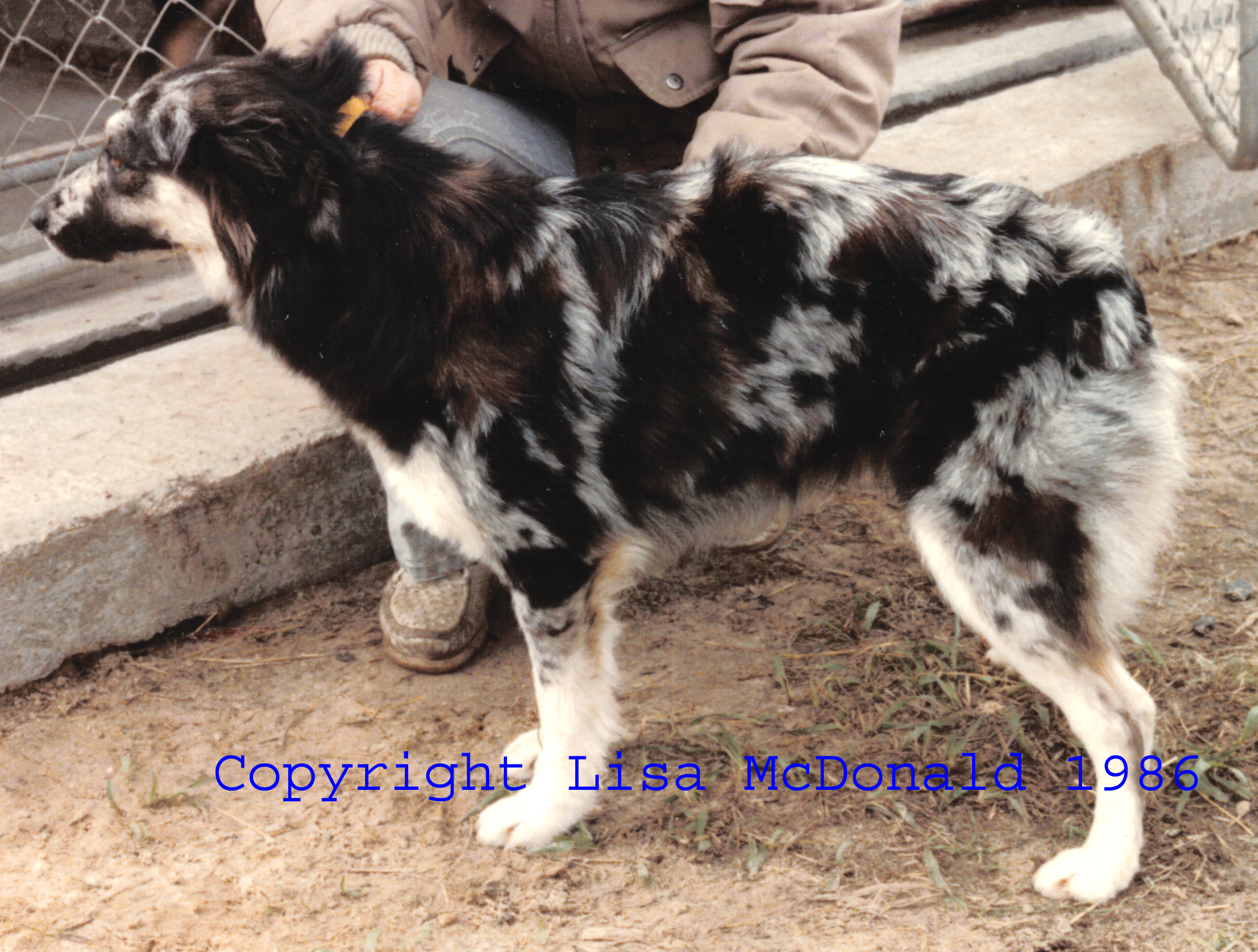
© 1999-2009 Lisa McDonald Comments